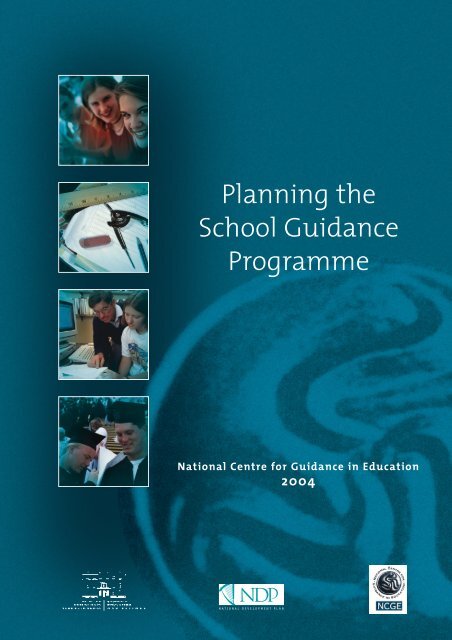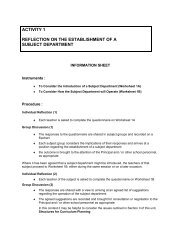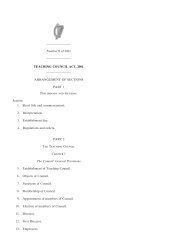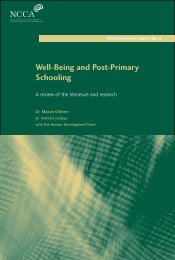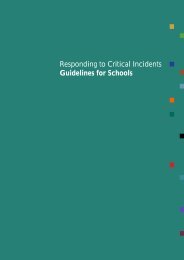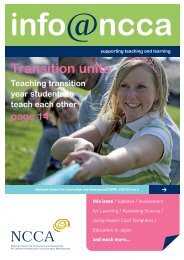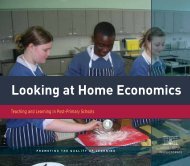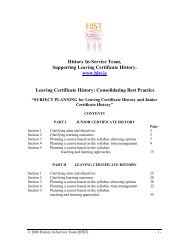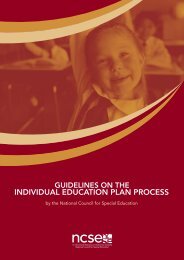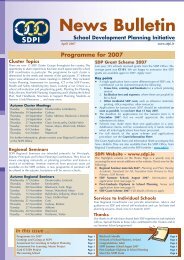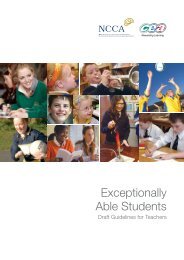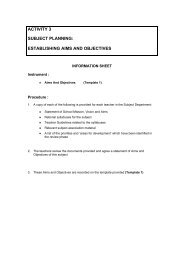Planning the School Guidance Programme - National Centre for ...
Planning the School Guidance Programme - National Centre for ...
Planning the School Guidance Programme - National Centre for ...
You also want an ePaper? Increase the reach of your titles
YUMPU automatically turns print PDFs into web optimized ePapers that Google loves.
<strong>Planning</strong> <strong>the</strong><br />
<strong>School</strong> <strong>Guidance</strong><br />
<strong>Programme</strong><br />
<strong>National</strong> <strong>Centre</strong> <strong>for</strong> <strong>Guidance</strong> in Education<br />
2004
<strong>Planning</strong> <strong>the</strong><br />
<strong>School</strong> <strong>Guidance</strong><br />
<strong>Programme</strong><br />
<strong>National</strong> <strong>Centre</strong> <strong>for</strong> <strong>Guidance</strong> in Education<br />
January 2004<br />
Published by <strong>the</strong> <strong>National</strong> <strong>Centre</strong> <strong>for</strong> <strong>Guidance</strong> in Education in association with <strong>the</strong><br />
Department of Education and Science.<br />
1st Floor, 42/43 Prussia Street, Dublin 7.<br />
www.ncge.ie
Foreword<br />
I am very pleased to present this<br />
publication <strong>Planning</strong> <strong>the</strong> <strong>School</strong> <strong>Guidance</strong><br />
<strong>Programme</strong> which has been prepared in<br />
<strong>the</strong> light of <strong>the</strong> requirements of sections 9<br />
(c) and 21 of <strong>the</strong> Education Act 1998. The<br />
publication will assist schools greatly in<br />
developing <strong>the</strong>ir guidance plan as part of<br />
<strong>the</strong> overall <strong>School</strong> Plan.<br />
The writing of <strong>Planning</strong> <strong>the</strong> <strong>School</strong><br />
<strong>Guidance</strong> <strong>Programme</strong> was co-ordinated<br />
by <strong>the</strong> <strong>National</strong> <strong>Centre</strong> <strong>for</strong> <strong>Guidance</strong> in<br />
Education, with inputs from <strong>the</strong> relevant<br />
stakeholders. I am most grateful to all<br />
who contributed to this work <strong>for</strong> <strong>the</strong>ir<br />
ef<strong>for</strong>t and commitment to <strong>the</strong> task.<br />
<strong>Guidance</strong> planning is a whole-school<br />
activity and is an integral part of <strong>the</strong><br />
<strong>School</strong> Development Plan. The guidance<br />
plan offers both a challenge and an<br />
opportunity <strong>for</strong> schools to develop<br />
programmes that ensure all students<br />
have access to appropriate guidance.<br />
As <strong>the</strong>se programmes require regular<br />
review and updating to ensure continued<br />
relevance to <strong>the</strong> ever-changing needs of<br />
<strong>the</strong> students in <strong>the</strong> school, <strong>the</strong> guidance<br />
plan is always a work in progress.<br />
As this document demonstrates, guidance<br />
planning draws not only on <strong>the</strong> expertise<br />
of <strong>the</strong> guidance counsellor but it also<br />
involves school management, staff,<br />
parents and students. I am certain that<br />
this document will be a valuable resource<br />
<strong>for</strong> all involved in guidance planning in<br />
schools. It will also assist in <strong>the</strong><br />
implementation of improved guidance<br />
programmes to assist all students in <strong>the</strong>ir<br />
transitions as <strong>the</strong>y progress from primary<br />
to second level and on to fur<strong>the</strong>r study<br />
and employment.<br />
I would like to congratulate <strong>the</strong> <strong>National</strong><br />
<strong>Centre</strong> <strong>for</strong> <strong>Guidance</strong> in Education on <strong>the</strong><br />
publication of <strong>Planning</strong> <strong>the</strong> <strong>School</strong><br />
<strong>Guidance</strong> <strong>Programme</strong>.<br />
Noel Dempsey, T.D.<br />
Minister <strong>for</strong> Education and<br />
Science
Contents<br />
Introduction 5<br />
Glossary 6<br />
Chapter 1<br />
Rationale and Context 7<br />
1.1 Overview<br />
1.2 Policy Developments and<br />
Recent Initiatives / Studies<br />
Chapter 2<br />
<strong>Guidance</strong> in <strong>School</strong>s 11<br />
2.1 What is <strong>Guidance</strong> in <strong>School</strong>s<br />
Chapter 3<br />
The <strong>School</strong> <strong>Guidance</strong> Plan 15<br />
3.1 The <strong>School</strong> <strong>Guidance</strong><br />
<strong>Programme</strong><br />
3.2 What is <strong>the</strong> <strong>School</strong><br />
<strong>Guidance</strong> Plan<br />
3.3 Key Elements of <strong>the</strong> <strong>School</strong><br />
<strong>Guidance</strong> Plan<br />
Chapter 4<br />
Defining Roles in <strong>the</strong> <strong>School</strong><br />
<strong>Guidance</strong> <strong>Programme</strong> 19<br />
4.1 Role of <strong>School</strong> Management, Staff<br />
and <strong>the</strong> Education Partners<br />
4.2 The Role of <strong>the</strong> <strong>Guidance</strong><br />
Counsellor<br />
Chapter 5<br />
The <strong>Planning</strong> Process 23<br />
5.1 Timeframe and Key Stages<br />
5.2 Starting <strong>the</strong> Process: Roles<br />
5.3 Consultative Mechanisms: Staff<br />
5.4 <strong>Guidance</strong> Needs Analysis<br />
5.5 Adoption of <strong>the</strong> Plan<br />
5.6 Follow up Actions and Review<br />
Bibliography 27<br />
APPENDICES<br />
Appendix I 29<br />
• Support Initiatives and Studies<br />
Appendix II 31<br />
• <strong>School</strong> <strong>Guidance</strong> Review (SGR)<br />
Sample Instruments:<br />
Form A (Students <strong>Guidance</strong> Needs:<br />
Existing Resources)<br />
Form B (<strong>Guidance</strong> Resources<br />
Inventory)<br />
Form C (Students <strong>Guidance</strong> Needs:<br />
Resources Required)<br />
Form D1 (Summary Results from<br />
Review – FORM A)<br />
Form D2 (Summary Results from<br />
Review – FORM B)<br />
Form E (Development Plan <strong>for</strong><br />
Improving <strong>the</strong> <strong>School</strong> <strong>Guidance</strong><br />
<strong>Programme</strong>)<br />
Appendix III 43<br />
• Action Plan<br />
Appendix IV 44<br />
• Allocation from <strong>the</strong> Department<br />
of Education and Science to<br />
Second Level <strong>School</strong>s <strong>for</strong><br />
<strong>Guidance</strong>
Introduction<br />
It is now widely recognised that guidance<br />
is an essential part of <strong>the</strong> learning<br />
process. The guidance service in Irish<br />
second level schools is well established<br />
and offers significant support to students<br />
as <strong>the</strong>y make important choices which<br />
will have lifelong implications <strong>for</strong> <strong>the</strong>m.<br />
The purpose of this publication is to help<br />
schools plan <strong>the</strong>ir guidance programmes<br />
in a productive manner. <strong>Guidance</strong><br />
planning should draw on contributions<br />
from school management, guidance<br />
counsellors, all school staff, parents and<br />
<strong>the</strong> students <strong>the</strong>mselves. The outcome<br />
should be a well-structured guidance<br />
plan which organises <strong>the</strong> resources of <strong>the</strong><br />
school to <strong>the</strong> best effect in meeting<br />
students’ needs.<br />
No two schools are identical, and <strong>the</strong>re is<br />
no such thing as an off-<strong>the</strong>-shelf<br />
guidance plan. This publication should<br />
help each school to analyse its particular<br />
context and circumstances, and to arrive<br />
at its own unique plan. The ef<strong>for</strong>t<br />
involved will be repaid handsomely in <strong>the</strong><br />
quality of <strong>the</strong> guidance programme<br />
which results.<br />
The process of devising this publication<br />
was a careful one, and involved<br />
widespread consultation. The experience<br />
gained through a pilot project on <strong>School</strong><br />
<strong>Guidance</strong> Review conducted by <strong>the</strong><br />
<strong>National</strong> <strong>Centre</strong> <strong>for</strong> <strong>Guidance</strong> in<br />
Education was of great benefit and fed<br />
into <strong>the</strong> development of this publication.<br />
The staff and Management Committee of<br />
<strong>the</strong> NCGE and <strong>the</strong> Inspectors of <strong>Guidance</strong><br />
from <strong>the</strong> Department of Education and<br />
Science have steered <strong>the</strong> document to its<br />
final <strong>for</strong>m with great diligence.<br />
The Education Act 1998 requires that<br />
students have access to appropriate<br />
guidance. A school which plans its<br />
programme in accordance with <strong>the</strong><br />
advice in this document will be giving<br />
itself <strong>the</strong> best foundation <strong>for</strong> delivering<br />
that entitlement to its students.<br />
Ed Riordan<br />
Chairperson<br />
NCGE<br />
5
Glossary<br />
DES<br />
FÁS<br />
HSCL<br />
GEI<br />
ICT<br />
IGC<br />
JCSP<br />
LCA<br />
LCVP<br />
LES<br />
NCGE<br />
NCTE<br />
NDP<br />
NEPS<br />
PLC<br />
SDPI<br />
SGR<br />
SPHE<br />
TYP<br />
Department of Education and Science<br />
Training and Employment Authority<br />
Home <strong>School</strong> Community Liaison<br />
<strong>Guidance</strong> Enhancement Initiative<br />
In<strong>for</strong>mation and Communication Technologies<br />
Institute of <strong>Guidance</strong> Counsellors<br />
Junior Certificate <strong>School</strong> <strong>Programme</strong><br />
Leaving Certificate Applied<br />
Leaving Certificate Vocational <strong>Programme</strong><br />
Local Employment Service<br />
<strong>National</strong> <strong>Centre</strong> <strong>for</strong> <strong>Guidance</strong> in Education<br />
<strong>National</strong> <strong>Centre</strong> <strong>for</strong> Technology in Education<br />
<strong>National</strong> Development Plan<br />
<strong>National</strong> Educational Psychological Service<br />
Post-Leaving Certificate<br />
<strong>School</strong> Development <strong>Planning</strong> Initiative<br />
<strong>School</strong> <strong>Guidance</strong> Review<br />
Social, Personal and Health Education<br />
Transition Year <strong>Programme</strong><br />
6
CHAPTER 1<br />
Rationale<br />
and Context<br />
7
Rationale Rationale and<br />
Rationale and context<br />
1.1<br />
OVERVIEW<br />
The purpose of this document is to provide<br />
schools and all interested parties with a<br />
comprehensive aid to understanding,<br />
developing and implementing a school’s<br />
guidance plan.This publication supersedes <strong>the</strong><br />
1996 Guidelines <strong>for</strong> <strong>the</strong> Practice of <strong>Guidance</strong><br />
and Counselling in <strong>School</strong>s.<br />
THE SCHOOL GUIDANCE PROGRAMME<br />
<strong>Guidance</strong> is provided through <strong>the</strong> school<br />
guidance programme. The guidance<br />
programme is <strong>the</strong> specific set of learning<br />
experiences which a school provides in<br />
response to <strong>the</strong> guidance needs of its<br />
students.<br />
<strong>School</strong>s are required in accordance with <strong>the</strong><br />
Education Act (1998) to ‘ensure that students<br />
have access to appropriate guidance’ (Section<br />
9c) 1 , with <strong>the</strong> consequence that guidance is an<br />
integral part of a school’s curricular activities.<br />
The Act also requires schools to develop a<br />
school plan based on <strong>the</strong> needs of <strong>the</strong> school 2 .<br />
The overall school plan should make specific<br />
reference to guidance and should incorporate<br />
a school guidance plan. The guidance planning<br />
process which is <strong>the</strong> subject of this publication<br />
will enable a school to define its priorities and<br />
to best deploy <strong>the</strong> resources available to it.<br />
THE SCHOOL GUIDANCE PLAN<br />
The school guidance plan is <strong>the</strong> document<br />
in which <strong>the</strong> school, in a systematic way,<br />
defines <strong>the</strong> guidance programme it offers,<br />
and states how resources are organised to<br />
deliver <strong>the</strong> programme. It should include:<br />
• Aims<br />
• Objectives<br />
• Resources<br />
• Target groups<br />
• Activities<br />
• Review<br />
In short: <strong>the</strong> school guidance plan is <strong>the</strong><br />
document which defines <strong>the</strong> school<br />
guidance programme.<br />
Throughout this publication <strong>the</strong> following<br />
terminology will be used. These terms will be<br />
explained in more detail in later Chapters.<br />
GUIDANCE IN SCHOOLS<br />
Refers to a range of learning experiences<br />
provided in a developmental sequence that<br />
assist students to make choices (personal<br />
and social, educational and career) about<br />
<strong>the</strong>ir lives and to make transitions<br />
consequent on <strong>the</strong>se choices.<br />
BENEFITS OF THE SCHOOL GUIDANCE<br />
PLAN<br />
A school guidance plan:<br />
provides direction - states <strong>the</strong> objectives and<br />
priorities of <strong>the</strong> provision of guidance in a<br />
school<br />
enhances <strong>the</strong> provision of guidance by<br />
targeting <strong>the</strong> needs of students<br />
focuses <strong>the</strong> school’s resources to where <strong>the</strong>y<br />
are needed most<br />
allows staff to contribute to developments and<br />
changes in a positive and collaborative way<br />
1 Education Act, 1988. Section 9c<br />
2 Ibid. Section 21.<br />
THE SCHOOL GUIDANCE PLAN IS AN INTEGRAL<br />
PART OF THE SCHOOL PLAN.<br />
8
context<br />
Rationale and context<br />
context<br />
Rationale and context<br />
1.2<br />
POLICY DEVELOPMENTS AND RECENT<br />
INITIATIVES / STUDIES<br />
This section gives a brief overview of relevant<br />
policy developments, studies and initiatives<br />
that <strong>for</strong>m <strong>the</strong> background and context <strong>for</strong><br />
<strong>Planning</strong> <strong>the</strong> <strong>School</strong> <strong>Guidance</strong> <strong>Programme</strong>.<br />
SCHOOL GUIDANCE REVIEW PILOT PROJECT<br />
(SGR), 1999-2000<br />
The aim of <strong>the</strong> project co-ordinated by <strong>the</strong><br />
NCGE was to assist schools to identify and<br />
plan a response to <strong>the</strong> changing guidance<br />
needs and competencies of students through<br />
<strong>the</strong> school’s guidance programme.<br />
1.2.1<br />
1.2.2<br />
POLICY<br />
EDUCATION ACT, 1998<br />
The Education Act requires <strong>the</strong> Board of<br />
Management of a school to develop a school<br />
plan based on <strong>the</strong> needs of <strong>the</strong> school. The<br />
school guidance plan <strong>for</strong>ms part of <strong>the</strong> school<br />
plan. <strong>School</strong>s are required by <strong>the</strong> Act to<br />
"ensure that students have access to<br />
appropriate guidance" (Section 9c). The Act<br />
outlines <strong>the</strong> responsibilities and functions of<br />
<strong>the</strong> Minister of Education and Science and of<br />
<strong>School</strong>s in respect of guidance.<br />
The Department of Education and Science’s<br />
Guidelines <strong>for</strong> Second Level <strong>School</strong>s on <strong>the</strong><br />
implications of Section 9 (c) of <strong>the</strong> Education<br />
Act (1998), relating to students’ access to<br />
appropriate guidance should be consulted in<br />
this regard.<br />
RECENT INITIATIVES AND STUDIES<br />
SCHOOL DEVELOPMENT PLANNING INITIATIVE<br />
(SDPI), 1999<br />
In May 1999 <strong>the</strong> Department of Education and<br />
Science announced a package to promote<br />
<strong>School</strong> Development <strong>Planning</strong> in first and<br />
second level schools.<br />
PRINCIPALS’ PERCEPTIONS OF THE GUIDANCE<br />
SERVICE IN POST PRIMARY SCHOOLS, 1998<br />
This study highlighted <strong>the</strong> fact that most<br />
guidance planning in schools was in<strong>for</strong>mal.<br />
AUDIT OF GUIDANCE IN POST-PRIMARY<br />
SCHOOLS, 2000<br />
An Audit of guidance provision in postprimary<br />
schools was conducted at request of<br />
<strong>the</strong> Department of Education and Science<br />
(DES) by <strong>the</strong> NCGE in 1999-2000.<br />
GUIDANCE ENHANCEMENT INITIATIVE (GEI),<br />
2001<br />
103 second level schools benefited from <strong>the</strong><br />
GEI which commenced in August 2001. These<br />
schools were granted additional guidance<br />
resources from <strong>the</strong> DES based on <strong>the</strong><br />
submission of a detailed proposal.<br />
MAKING A EUROPEAN AREA OF LIFELONG<br />
LEARNING A REALITY, 2001<br />
This policy document by <strong>the</strong> European<br />
Commission recognises <strong>the</strong> importance of<br />
guidance as a key element of lifelong<br />
learning.<br />
(please consult Appendix I)<br />
9
CHAPTER 2<br />
<strong>Guidance</strong> in<br />
<strong>School</strong>s<br />
11
<strong>Guidance</strong> in s<br />
<strong>Guidance</strong> in s<br />
<strong>Guidance</strong> in schools<br />
2.1<br />
2.1.1<br />
WHAT IS GUIDANCE IN SCHOOLS<br />
<strong>Guidance</strong> refers to a range of learning<br />
experiences provided in a developmental<br />
sequence, designed to assist students to make<br />
choices about <strong>the</strong>ir lives and to make<br />
transitions consequent on <strong>the</strong>se choices.<br />
These choices may be categorised into three<br />
separate but interlinked areas:<br />
• personal and social<br />
• educational<br />
• career.<br />
<strong>Guidance</strong> provision in schools involves a range<br />
of guidance and counselling activities and<br />
services [see <strong>the</strong> Department of Education and<br />
Science’s Guidelines <strong>for</strong> Second Level <strong>School</strong>s on<br />
<strong>the</strong> implications of Section 9 (c) of <strong>the</strong> Education<br />
Act (1998), relating to students’ access to<br />
appropriate guidance (Section 1) <strong>for</strong> an<br />
overview on <strong>the</strong> importance of guidance]. The<br />
terms ‘guidance counselling’ and ‘guidance<br />
and counselling’ are covered by this definition<br />
and are synonymous with <strong>the</strong> range of<br />
activities set out below. In this publication, <strong>the</strong><br />
term ‘guidance’ is used <strong>for</strong> simplicity and<br />
encompasses that broad range<br />
of activities.<br />
GUIDANCE ACTIVITIES THAT ASSIST<br />
STUDENTS TO MAKE CHOICES INCLUDE:<br />
• Assessment - helping students to obtain a<br />
better self-understanding through <strong>the</strong> use<br />
of psychometric tests and o<strong>the</strong>r inventories.<br />
• In<strong>for</strong>mation - providing students with<br />
objective and factual data on education and<br />
training opportunities, occupations, labour<br />
market in<strong>for</strong>mation, entitlements etc.<br />
• Advice - making suggestions based on <strong>the</strong><br />
advisor’s own knowledge and experience.<br />
• Educational Development <strong>Programme</strong>s -<br />
facilitating <strong>the</strong> transfer of knowledge and<br />
skills relating to studying, examination<br />
per<strong>for</strong>mance, choices of subjects and levels.<br />
• Personal and Social Development<br />
<strong>Programme</strong>s - facilitating <strong>the</strong> transfer of<br />
knowledge and skills relating to a student’s<br />
personal and social development, selfawareness,<br />
decision-making and planning.<br />
• Referral - this includes two types of activity:<br />
i) referral of an individual student by <strong>the</strong><br />
guidance counsellor to o<strong>the</strong>r Professionals<br />
outside of <strong>the</strong> school, e.g. The <strong>National</strong><br />
Educational Psychological Service (NEPS);<br />
ii) referral of an individual student to <strong>the</strong><br />
guidance counsellor by teachers, Board of<br />
Management, school management, and<br />
parents. The voluntary participation in<br />
counselling of <strong>the</strong> referred student must<br />
be respected by all concerned.<br />
• Counselling - helping students to explore<br />
<strong>the</strong>ir thoughts and feelings, and <strong>the</strong> choices<br />
open to <strong>the</strong>m; giving care and support to<br />
students learning to cope with <strong>the</strong> many<br />
aspects of growing up.<br />
12
chools<br />
<strong>Guidance</strong> in schools<br />
chools<br />
<strong>Guidance</strong> in schools<br />
2.1.2<br />
GUIDANCE ACTIVITIES THAT ASSIST<br />
STUDENTS TO MAKE TRANSITIONS<br />
INCLUDE:<br />
• Careers education/career transition<br />
programmes - enabling students to make<br />
transitions to fur<strong>the</strong>r and higher education,<br />
training and employment.<br />
• Placement - work experience, work<br />
shadowing, and preparing students <strong>for</strong><br />
employment.<br />
• Follow-up - following up <strong>for</strong>mer students<br />
regarding progression routes and<br />
destinations.<br />
2.1.4<br />
The nature and range of guidance activities<br />
outlined in 2.1.1 to 2.1.3 above are based on <strong>the</strong><br />
premise that guidance is both a whole school<br />
concern and a specialist area within education.<br />
2.1.3<br />
OTHER GUIDANCE ACTIVITIES THAT<br />
SUPPORT THE ACHIEVEMENT OF THE<br />
AIMS OF THE SCHOOL GUIDANCE<br />
PROGRAMME INCLUDE:<br />
• Consultation with parents, school staff and<br />
students.<br />
• Feedback - giving feedback to <strong>the</strong> Board of<br />
Management, school management and<br />
staff on <strong>the</strong> needs of individual students,<br />
groups and <strong>the</strong> school as an organisation,<br />
and how <strong>the</strong> school guidance programme<br />
has supported students’ choices and<br />
transitions.<br />
• Networking - establishing links with<br />
employers, relevant agencies and<br />
institutions to enhance guidance work with<br />
students.<br />
• Promoting change - assisting curriculum<br />
development in <strong>the</strong> school.<br />
• Managing, organising and co-ordinating<br />
guidance activities into a coherent<br />
programme.<br />
13
CHAPTER 3<br />
The <strong>School</strong><br />
<strong>Guidance</strong> Plan<br />
This chapter explains <strong>the</strong> components of and <strong>the</strong> planning of a<br />
school guidance programme.<br />
15
<strong>School</strong> guidan<br />
<strong>School</strong> guidan<br />
<strong>School</strong> guidance plan<br />
3.1<br />
3.2<br />
16<br />
THE SCHOOL GUIDANCE PROGRAMME is <strong>the</strong><br />
specific set of learning experiences which a<br />
school provides in response to <strong>the</strong> guidance<br />
needs of its students. There are a number of<br />
principles that underpin <strong>the</strong> school guidance<br />
programme.<br />
PRINCIPLES<br />
The school guidance programme should:<br />
• Be accessible<br />
• Recognise that guidance is a specialist<br />
area within education<br />
• Recognise that guidance is a whole<br />
school concern<br />
• Be impartial<br />
• Be student centred<br />
• Be transparent<br />
• Be balanced<br />
• Be inclusive<br />
• Be responsive<br />
• Respect confidentiality in counselling<br />
and assessment activities<br />
• Empower participants to take<br />
responsibility <strong>for</strong> <strong>the</strong>ir own<br />
development<br />
• Promote equal opportunities<br />
• Deploy and make full use of available<br />
resources<br />
• Be reviewed on an ongoing basis<br />
WHAT IS THE SCHOOL GUIDANCE PLAN<br />
The school guidance plan is a structured<br />
document that describes <strong>the</strong> school guidance<br />
programme and specifies how <strong>the</strong> guidance<br />
needs of students are to be addressed. The<br />
school guidance plan is drawn up in<br />
consultation with all school partners in order to<br />
ensure that it reflects <strong>the</strong> identified needs of<br />
students. The school guidance plan is an<br />
integral part of <strong>the</strong> school’s overall plan. It is<br />
developmental by design and includes<br />
sequential activities organised and<br />
3.3<br />
3.3.1<br />
implemented as a collaborative ef<strong>for</strong>t by<br />
guidance counsellors, teachers, school<br />
management and <strong>the</strong> Board of Management,<br />
programme teams, students and parents. The<br />
various roles are defined in more detail in<br />
section 4.<br />
The school guidance plan outlines and<br />
describes <strong>the</strong> guidance programme, that is, <strong>the</strong><br />
full range of activities through which <strong>the</strong> school<br />
addresses <strong>the</strong> needs of <strong>the</strong> students by helping<br />
<strong>the</strong>m in <strong>the</strong>ir personal and social, educational<br />
and career development.<br />
KEY ELEMENTS OF THE SCHOOL GUIDANCE<br />
PLAN<br />
The school guidance plan should address <strong>the</strong><br />
following questions:<br />
(i) What does <strong>the</strong> school aim to provide<br />
through its guidance programme (AIMS)<br />
(ii) Who/which persons are <strong>the</strong> priorities <strong>for</strong><br />
benefiting from <strong>the</strong> provision<br />
(TARGET GROUPS)<br />
(iii) Which guidance outcomes are intended<br />
<strong>for</strong> <strong>the</strong> target groups (OBJECTIVES)<br />
(iv) How are <strong>the</strong>se guidance outcomes to be<br />
achieved (ACTIVITIES)<br />
(v) What resources are available to support<br />
<strong>the</strong>se outcomes (RESOURCES)<br />
(vi) How does a school find out if <strong>the</strong><br />
objectives have been achieved<br />
(MONITORING AND REVIEW)<br />
AIMS<br />
The aims can be derived from a variety of<br />
sources, contexts and players <strong>for</strong> example:<br />
(i) The definition of guidance as per 2.1<br />
above.<br />
(ii) The Education Act (1998) as per 1.2.1 above.<br />
(iii) The Department of Education and<br />
Science’s Guidelines <strong>for</strong> Second Level<br />
<strong>School</strong>s on <strong>the</strong> implications of Section 9 (c)
ce plan<br />
<strong>School</strong> guidance plan<br />
ce plan<br />
<strong>School</strong> guidance plan<br />
3.3.2<br />
of <strong>the</strong> Education Act (1998), relating to<br />
students’ access to appropriate guidance.<br />
(iv) The school’s mission statement, vision<br />
and fundamental aims as per <strong>the</strong> school<br />
plan.<br />
(v) The specific social and economic<br />
environment in which <strong>the</strong> school<br />
operates.<br />
(vi) The views of school partners (students,<br />
parents, staff, management, local<br />
community) on how existing resource<br />
provision can best be utilised.<br />
(vii) The identified needs of target groups.<br />
(viii) The demands of <strong>the</strong> local/regional,<br />
national, social and economic<br />
environments.<br />
(ix) The school’s current guidance<br />
programme.<br />
TARGET GROUPS<br />
One of <strong>the</strong> principal benefits of <strong>the</strong> school<br />
guidance plan is that available resources are<br />
utilised to meet identified needs and<br />
priorities. The school guidance programme<br />
should take into account <strong>the</strong> needs of all<br />
students at all levels within <strong>the</strong> school. The<br />
programme should provide a balance in <strong>the</strong><br />
personal and social, educational and career<br />
guidance offered.<br />
Within <strong>the</strong> resources available <strong>for</strong> guidance,<br />
schools may need to prioritise certain groups<br />
of students during <strong>the</strong> school year. Prioritising<br />
is a value judgement made by <strong>the</strong> school in<br />
terms of its overall mission, <strong>the</strong> needs<br />
identified, <strong>the</strong> resources available, and <strong>the</strong><br />
local, national, social and economic<br />
environment in which <strong>the</strong> school operates.<br />
These decisions should be based in particular<br />
on <strong>the</strong> aims of <strong>the</strong> school guidance plan. In<br />
setting priorities schools should carefully<br />
3.3.3<br />
3.3.4<br />
consider <strong>the</strong> needs of <strong>the</strong> community in which<br />
<strong>the</strong> school is based and also national priorities.<br />
For example, both <strong>the</strong> <strong>National</strong> Development<br />
Plan (NDP) and <strong>the</strong> New Deal on Educational<br />
Disadvantage have identified assisting young<br />
people at risk as a priority <strong>for</strong> school guidance<br />
services.<br />
OBJECTIVES (GUIDANCE OUTCOMES)<br />
Once <strong>the</strong> aims and target groups are clear, <strong>the</strong><br />
next issue is to decide on specific guidance<br />
outcomes <strong>for</strong> particular target groups.<br />
Objectives (guidance outcomes) should be set<br />
corresponding to each aim and should take<br />
into account available resources. Objectives<br />
should be clear, realistic, specific and<br />
measurable and have a timeframe. In general,<br />
objectives should be framed in active language<br />
and should list competencies such as to<br />
identify, acquire, demonstrate, know, develop,<br />
compare and contrast, etc. The Department of<br />
Education and Science’s Guidelines <strong>for</strong> Second<br />
Level <strong>School</strong>s on <strong>the</strong> implications of Section 9 (c)<br />
of <strong>the</strong> Education Act (1998), relating to students’<br />
access to appropriate guidance contains<br />
valuable in<strong>for</strong>mation on knowledge, skills and<br />
competencies <strong>for</strong> <strong>the</strong> various stages of second<br />
level education.<br />
GUIDANCE ACTIVITIES<br />
A very broad range of guidance activities can<br />
be called into play as <strong>the</strong> means by which <strong>the</strong><br />
objectives are to be realised. Please refer to:<br />
2.1.1: <strong>Guidance</strong> activities that assist students<br />
to make choices<br />
2.1.2: <strong>Guidance</strong> activities that assist students<br />
to make transitions<br />
2.1.3: O<strong>the</strong>r guidance activities that support<br />
<strong>the</strong> achievement of <strong>the</strong> aims of <strong>the</strong><br />
school guidance programme.<br />
17
<strong>School</strong> guidan<br />
<strong>School</strong> guidan<br />
<strong>School</strong> guidance plan<br />
3.3.5<br />
RESOURCES<br />
Resources describe <strong>the</strong> personnel, time<br />
allocation, equipment, materials, physical<br />
locations and finance required <strong>for</strong> <strong>the</strong><br />
per<strong>for</strong>mance of <strong>the</strong> guidance activities and <strong>the</strong><br />
management of <strong>the</strong> school guidance<br />
programme.<br />
<strong>School</strong> and Community Resources<br />
• Board of Management and Principal.<br />
• <strong>Guidance</strong> counsellor(s).<br />
• Subject teachers and <strong>the</strong> learning support<br />
teacher(s).<br />
• Staff with <strong>for</strong>mal roles (year head, class<br />
tutor, etc).<br />
• In-school programme support teams.<br />
• Parents.<br />
• Students.<br />
• <strong>School</strong> budget – part of <strong>the</strong> school budget<br />
should be dedicated <strong>for</strong> <strong>the</strong> purchase of<br />
materials <strong>for</strong> guidance e.g. psychometric<br />
tests, career materials.<br />
• The guidance suite (office, careers library etc).<br />
• Classrooms.<br />
• Computer facilities - access by students <strong>for</strong><br />
guidance purposes should be standard in<br />
both <strong>the</strong> school guidance plan and in <strong>the</strong><br />
school’s ICT plan.<br />
• Community (workplace, referral, etc).<br />
<strong>National</strong> Resources<br />
• The Department of Education and Science,<br />
agencies such as <strong>the</strong> <strong>National</strong> <strong>Centre</strong> <strong>for</strong><br />
<strong>Guidance</strong> in Education (NCGE), <strong>the</strong> <strong>National</strong><br />
Educational Psychological Service (NEPS), <strong>the</strong><br />
<strong>National</strong> <strong>Centre</strong> <strong>for</strong> Technology in Education<br />
(NCTE).<br />
• Professional bodies and associations such as<br />
<strong>the</strong> Institute of <strong>Guidance</strong> Counsellors (IGC),<br />
teacher unions and management bodies.<br />
3.3.6<br />
• The <strong>School</strong> Development <strong>Planning</strong> Initiative<br />
and o<strong>the</strong>r national initiatives’ support teams.<br />
• ICT, video and printed national resources.<br />
• Test materials.<br />
Included in <strong>the</strong> appendices of this publication is<br />
a questionnaire to examine <strong>the</strong> resources<br />
available <strong>for</strong> <strong>the</strong> provision of guidance in <strong>the</strong><br />
school (Appendix II, Form B). This questionnaire<br />
can be adapted to suit <strong>the</strong> needs of <strong>the</strong> school.<br />
MONITORING AND REVIEW<br />
The school guidance plan must make provision<br />
<strong>for</strong> ongoing monitoring (on an annual basis)<br />
and review (a major re-design on a longer<br />
timescale, perhaps every three years). A school<br />
needs to identify (i) <strong>the</strong> extent to which<br />
guidance objectives are being achieved, (ii) <strong>the</strong><br />
factors that facilitate or hinder that<br />
achievement, and (iii) unplanned outcomes,<br />
unmet needs, and possibly new/emerging<br />
target groups. This process assists <strong>the</strong> school in<br />
<strong>for</strong>ward planning so that <strong>the</strong> school guidance<br />
programme remains relevant to <strong>the</strong> needs of<br />
<strong>the</strong> students.<br />
There are different ways in which monitoring<br />
and review may be supported, <strong>for</strong> example:<br />
• Soliciting <strong>the</strong> views of school partners.<br />
• Development of a summary report of activity<br />
with a critical analysis by <strong>the</strong> guidance<br />
counsellor.<br />
• Follow up studies of <strong>the</strong> target groups.<br />
Monitoring should be an on-going activity. A<br />
written report <strong>for</strong> <strong>the</strong> Board of Management of<br />
<strong>the</strong> school should be prepared on a regular<br />
basis e.g. annually.<br />
18
CHAPTER 4<br />
Defining Roles in<br />
<strong>the</strong> <strong>School</strong> <strong>Guidance</strong><br />
<strong>Programme</strong><br />
19
Defining rol<br />
Defining roles<br />
Defining<br />
4.1<br />
4.1.1<br />
4.1.2<br />
4.1.3<br />
ROLE OF SCHOOL MANAGEMENT, STAFF<br />
AND THE EDUCATION PARTNERS<br />
The Board of Management and school<br />
management team have a responsibility to<br />
ensure that <strong>the</strong> provision and practice of<br />
guidance in <strong>the</strong> school is of <strong>the</strong> highest<br />
possible standard. This includes managing<br />
<strong>the</strong> process of guidance planning in cooperation<br />
with <strong>the</strong> guidance counsellor,<br />
school staff 1 and o<strong>the</strong>r school partners such<br />
as parents. Each school is required to comply<br />
with <strong>the</strong> Education Act (1998) and provide<br />
students with "access to appropriate<br />
guidance".<br />
<strong>Guidance</strong> counsellors because of <strong>the</strong>ir<br />
specialist training have a professional role in<br />
each of <strong>the</strong> main areas of guidance: personal<br />
and social, educational, and career. In<br />
addition <strong>the</strong> guidance counsellor has a key<br />
role in collaborating with school management<br />
in <strong>the</strong> development and review of <strong>the</strong> school<br />
guidance plan and <strong>the</strong> integration of<br />
guidance into <strong>the</strong> curriculum. This role of <strong>the</strong><br />
guidance counsellor is explored in more detail<br />
in section 4.2 below.<br />
Subject teachers may have a key role in<br />
providing support to students and<br />
in<strong>for</strong>mation and advice relating to <strong>the</strong>ir<br />
subject disciplines and related careers. Some<br />
teachers have additional <strong>for</strong>mal<br />
responsibilities through management,<br />
pastoral care roles, co-ordination roles and<br />
through participation in programmes such as<br />
SPHE. Individual teachers may be sought out<br />
by students on an in<strong>for</strong>mal basis <strong>for</strong> advice<br />
and in<strong>for</strong>mation. All teachers may consult<br />
with <strong>the</strong> guidance counsellor on <strong>the</strong> needs of<br />
an individual student and/or refer <strong>the</strong> student<br />
to <strong>the</strong> guidance counsellor when specialist<br />
competence is required with due regard to<br />
confidentiality.<br />
4.1.4 Parents have by far <strong>the</strong> most influence,<br />
directly or indirectly, on <strong>the</strong> choices made by<br />
young people. Parents have a major influence<br />
on <strong>the</strong> environment in which <strong>the</strong> young<br />
person lives including values, attitudes and<br />
lifestyle. Parents have an important part to<br />
play in helping to establish <strong>the</strong> needs and<br />
priorities of <strong>the</strong> school guidance programme<br />
and in supporting <strong>the</strong> programme. Parents<br />
can also participate in <strong>the</strong> guidance process<br />
through<br />
(i) Consultation with <strong>the</strong> guidance<br />
counsellor and o<strong>the</strong>r school staff.<br />
(ii) Attendance at relevant in<strong>for</strong>mation and<br />
o<strong>the</strong>r meetings at school.<br />
(iii) Contributing to <strong>the</strong> development and<br />
review of <strong>the</strong> school guidance plan.<br />
and when possible<br />
(iv) Providing personal assistance to <strong>the</strong><br />
school guidance programme.<br />
4.1.5<br />
4.1.6<br />
Students are <strong>the</strong> focus of <strong>the</strong> school guidance<br />
programme and are entitled to have an input<br />
into <strong>the</strong> development of <strong>the</strong> school guidance<br />
plan. In particular, students (through <strong>the</strong><br />
Student Council) can help to identify and<br />
establish <strong>the</strong> needs and priorities of <strong>the</strong><br />
guidance programme. Their feedback in <strong>the</strong><br />
review process is also highly important.<br />
The local community through its agencies,<br />
organisations and institutions provides<br />
young people with resources <strong>for</strong> career<br />
1 (particularly Home-<strong>School</strong>-Community Liaison - HSCL, Pastoral Care, Learning Support Teacher, and <strong>Programme</strong> Co-ordinators <strong>for</strong> Transition<br />
20<br />
Year <strong>Programme</strong> - TYP, Leaving Certificate Applied - LCA, Leaving Certificate Vocational <strong>Programme</strong> - LCVP, Social, Personal and Health<br />
Education - SPHE).
es<br />
roles<br />
Defining roles<br />
Defining roles<br />
4.1.7<br />
4.2<br />
4.2.1<br />
exploration, in<strong>for</strong>mation and o<strong>the</strong>r <strong>for</strong>ms of<br />
assistance and support. Such agencies,<br />
organisations and institutions include<br />
providers of training, fur<strong>the</strong>r and higher<br />
education, employment and youth services.<br />
In some instances, <strong>the</strong> guidance needs of<br />
young people may require referral to<br />
professionals outside <strong>the</strong> school.<br />
THE ROLE OF THE GUIDANCE<br />
COUNSELLOR<br />
<strong>Guidance</strong> counsellors are professionally<br />
trained to undertake <strong>the</strong> following tasks<br />
within <strong>the</strong> school guidance programme:<br />
Counselling: empowering students to make<br />
decisions, solve problems, change behaviours<br />
and resolve issues in <strong>the</strong>ir lives. Such activity<br />
may be personal counselling, educational<br />
counselling, career counselling, or it may<br />
involve combinations of each. Counselling is a<br />
key part of <strong>the</strong> school guidance programme,<br />
offered on an individual or group basis as part<br />
of a developmental learning process and at<br />
moments of personal crisis.<br />
Counselling on an individual basis should be<br />
part of <strong>the</strong> support structure that a school<br />
provides to students. Within <strong>the</strong> overall time<br />
allocated <strong>for</strong> guidance, adequate time should<br />
be given <strong>for</strong> <strong>the</strong> counselling function in <strong>the</strong><br />
guidance programme. The rationale <strong>for</strong> <strong>the</strong><br />
time allocated and its usage should be<br />
evident in <strong>the</strong> school guidance plan. See <strong>the</strong><br />
Department of Education and Science’s<br />
Guidelines <strong>for</strong> Second Level <strong>School</strong>s on <strong>the</strong><br />
4.2.2<br />
4.2.3<br />
4.2.4<br />
4.2.5<br />
implications of Section 9 (c) of <strong>the</strong> Education<br />
Act (1998), relating to students’ access to<br />
appropriate guidance.<br />
Support: The guidance counsellor provides<br />
support to parents, teachers, <strong>the</strong> school<br />
principal, Board of Management and referral<br />
agencies in assisting <strong>the</strong> personal and social,<br />
career and educational development of<br />
students. Such support may include advocacy<br />
on behalf of a student. Support also refers to<br />
assistance in <strong>the</strong> planning and development<br />
of SPHE, JCSP 1 ,TYP,LCA,LCVP,PLC 2 guidance<br />
related activities.<br />
Assessment: The guidance counsellor is<br />
trained to use a range of psychometric tests<br />
and o<strong>the</strong>r evaluative instruments to support<br />
relevant objectives of <strong>the</strong> school guidance<br />
programme. Such objectives may be related to<br />
career and educational planning, personal<br />
decision making and development of selfawareness.<br />
In<strong>for</strong>mation: Assisting students to acquire,<br />
interpret and use in<strong>for</strong>mation relevant to<br />
<strong>the</strong>ir personal and social, educational and<br />
career development.<br />
Classroom <strong>Guidance</strong> Activities: Providing<br />
classroom based learning experiences that<br />
are relevant to <strong>the</strong> objectives of <strong>the</strong> school<br />
guidance programme. Such experiences may<br />
include in<strong>for</strong>mation giving, in<strong>for</strong>mation and<br />
communication technologies (ICT), skills<br />
development (e.g. planning, decision-making,<br />
study skills, communication, values<br />
clarification), and vocational preparation.<br />
1 JCSP - Junior Certificate <strong>School</strong> <strong>Programme</strong><br />
2 PLC - Post - Leaving Certificate<br />
21
4.2.6 <strong>Planning</strong> and Organising Workplace<br />
Learning: <strong>School</strong>s need to make provision <strong>for</strong><br />
work based or work simulation learning<br />
experiences relevant to <strong>the</strong> personal and<br />
social, educational and career learning<br />
objectives of <strong>the</strong> school guidance programme.<br />
Such experiences include work experience,<br />
work shadowing, visits to workplaces, training<br />
centres and higher education institutes etc.<br />
The guidance counsellor should be involved<br />
and consulted in this field.<br />
4.2.7<br />
Referrals: Seeking <strong>for</strong> students <strong>the</strong> assistance<br />
of non-school based professionals e.g. NEPS,<br />
following standard procedures. The guidance<br />
counsellor also provides support <strong>for</strong> students<br />
referred to him/her by teachers, parents, and<br />
school management. The voluntary<br />
participation by <strong>the</strong> individual concerned<br />
should be respected.<br />
4.2.8 Professional Development: The guidance<br />
counsellor should keep abreast of on-going<br />
changes in <strong>the</strong> fields of training, education,<br />
work and child welfare. The Board of<br />
Management and school management<br />
should facilitate <strong>the</strong> attendance of <strong>the</strong><br />
guidance counsellor at relevant events and at<br />
in-career professional training during <strong>the</strong><br />
school year. Participation in <strong>the</strong>se events<br />
should be related to <strong>the</strong> objectives of <strong>the</strong><br />
school guidance programme. Attendance at<br />
non-school based events should be<br />
negotiated/agreed in advance between <strong>the</strong><br />
Board of Management, school management<br />
and <strong>the</strong> guidance counsellor.<br />
22
CHAPTER 5<br />
The <strong>Planning</strong><br />
Process<br />
This section examines <strong>the</strong> considerations that need to be taken into<br />
account in starting <strong>the</strong> guidance planning process<br />
23
The planning<br />
The planning process<br />
The planning T<br />
5.1<br />
5.2<br />
TIMEFRAMES AND KEY STAGES<br />
<strong>School</strong>s should establish a timeframe <strong>for</strong> <strong>the</strong><br />
development of <strong>the</strong> guidance plan and <strong>for</strong> its<br />
monitoring and review. This requires a<br />
significant time input by school staff. The<br />
amount of time will vary from school to school.<br />
Some schools may already have a <strong>School</strong><br />
Development Plan and/or a guidance<br />
programme in place that meets or partially<br />
addresses <strong>the</strong> model presented in this<br />
publication. For such schools an accelerated<br />
time frame may apply.<br />
Table 1 represents an indicative timeframe <strong>for</strong><br />
<strong>the</strong> different stages involved when developing<br />
a plan <strong>for</strong> <strong>the</strong> first time.<br />
STARTING THE PLANNING PROCESS: ROLES<br />
• The Board of Management through <strong>the</strong><br />
Principal has a responsibility to initiate<br />
guidance planning, and to motivate staff to<br />
participate in <strong>the</strong> process.<br />
5.3<br />
• The guidance counsellor has a lead role to<br />
play in <strong>the</strong> process of guidance planning<br />
because of his/her specialist training and<br />
responsibilities.<br />
• All staff in <strong>the</strong> school have a part to play in<br />
<strong>the</strong> guidance programme and should be<br />
encouraged to take an active part in <strong>the</strong><br />
process.<br />
CONSULTATIVE MECHANISMS - STAFF<br />
It is vital to include staff from <strong>the</strong> earliest<br />
stages of <strong>the</strong> planning process, and to engage<br />
<strong>the</strong>ir participation. <strong>School</strong> staff will need to be:<br />
• Briefed on provisions of <strong>the</strong> Education Act<br />
regarding guidance.<br />
• Briefed on <strong>the</strong> current guidance service<br />
offered in <strong>the</strong> school.<br />
• Briefed on what guidance planning is<br />
about.<br />
• Invited to make <strong>the</strong>ir input into <strong>the</strong><br />
guidance plan.<br />
TABLE ONE:<br />
INDICATIVE TIMEFRAME FOR STAGES OF THE FIRST TIME DEVELOPMENT OF THE<br />
SCHOOL GUIDANCE PLAN<br />
STAGES OF THE GUIDANCE PLAN YEAR 1 YEAR 2<br />
TERM 1 TERM 2 TERM 3 TERM 1 TERM 2 TERM 3<br />
1. Developing Rationale / Aims ✓<br />
2. Target Groups ✓ ✓<br />
3. Developing Objectives <strong>for</strong> <strong>the</strong><br />
<strong>Guidance</strong> Plan ✓ ✓ ✓ ✓<br />
4. Developing <strong>Guidance</strong> Activities ✓ ✓ ✓ ✓ ✓<br />
5. Identification of Resources ✓ ✓ ✓ ✓ ✓<br />
6. Monitoring and Review ✓ ✓ ✓<br />
Some of <strong>the</strong> activities overlap in <strong>the</strong> timeframe and some are continuous during <strong>the</strong> timeframe. The<br />
pace at which <strong>the</strong> school plan develops depends on <strong>the</strong> management and staff time available,<br />
whe<strong>the</strong>r <strong>the</strong> school has an existing school guidance plan, <strong>the</strong> stage <strong>the</strong> school is at in <strong>the</strong><br />
development of <strong>the</strong> school plan etc. Some schools may <strong>the</strong>re<strong>for</strong>e be in a position to expedite <strong>the</strong><br />
process indicated in <strong>the</strong> table above.<br />
24
process<br />
he planning process<br />
process<br />
The planning process<br />
Drawing on <strong>the</strong> experience of <strong>the</strong> <strong>School</strong><br />
<strong>Guidance</strong> Review (SGR) <strong>the</strong> engagement and<br />
participation of all staff could be achieved by<br />
one of <strong>the</strong> following approaches.<br />
(i) The school principal and guidance<br />
counsellor meet in advance to plan <strong>the</strong><br />
staff consultation exercise. A staff meeting<br />
is <strong>the</strong>n held where staff divide into<br />
working groups. Each working group could<br />
focus on <strong>the</strong> guidance needs of a specific<br />
year group.<br />
or<br />
(ii) A core staff group - e.g. guidance<br />
counsellor, year heads / pastoral care team<br />
meet in advance to draft a short document<br />
giving an overview of <strong>the</strong> current guidance<br />
provision and <strong>the</strong> guidance planning<br />
process. The document is <strong>the</strong>n presented<br />
to staff meeting(s), school management,<br />
and <strong>the</strong> education partners <strong>for</strong> additional<br />
comments.<br />
<strong>School</strong>s will naturally devise <strong>the</strong>ir own<br />
variations on <strong>the</strong> above approaches. The<br />
important issue is to ensure broad<br />
consultation and <strong>the</strong> encouragement of a<br />
sense of school-wide ownership of guidance<br />
planning.<br />
As <strong>the</strong> guidance planning process develops,<br />
each of <strong>the</strong> elements of <strong>the</strong> guidance plan will<br />
need to be addressed. These were set out in<br />
section 3.3 as follows:<br />
• AIMS<br />
• TARGET GROUPS<br />
• OBJECTIVES<br />
• ACTIVITIES<br />
• RESOURCES<br />
• MONITORING AND REVIEW<br />
5.4<br />
Each of <strong>the</strong>se elements should be derived<br />
from <strong>the</strong> widest possible staff participation.<br />
This will reduce <strong>the</strong> possibilities of <strong>the</strong><br />
guidance plan being marginalised. Such staffwide<br />
participation should flow naturally from<br />
<strong>the</strong> initial approach outlined above.<br />
GUIDANCE NEEDS ANALYSIS<br />
There are many methods <strong>for</strong> establishing<br />
students’ guidance needs:<br />
• Consulting <strong>the</strong> Students’ Council /<br />
surveying <strong>the</strong> students <strong>the</strong>mselves.<br />
• Consulting parents.<br />
• Eliciting <strong>the</strong> needs of students through<br />
‘brainstorming’ by staff.<br />
• Consulting local employers.<br />
• Consulting past students of <strong>the</strong> school.<br />
• Consulting relevant advisory publications.<br />
The ideal approach is to have a combination<br />
of <strong>the</strong>se activities and methods.<br />
The needs assessment can be conducted by<br />
interviews (this is time consuming but allows<br />
<strong>for</strong> in-depth in<strong>for</strong>mation to be ga<strong>the</strong>red),<br />
focus groups, or through <strong>the</strong> use of<br />
questionnaires. The participation of students<br />
in <strong>the</strong> process is strongly recommended.<br />
Two of <strong>the</strong> schools in <strong>the</strong> SGR pilot project<br />
elicited <strong>the</strong> views of students in relation to<br />
<strong>the</strong>ir guidance needs. They found this to be a<br />
very useful exercise and discovered a number<br />
of student needs of which staff were not<br />
aware. Ano<strong>the</strong>r school asked <strong>the</strong> Parents<br />
Council <strong>for</strong> <strong>the</strong>ir views and again found this to<br />
be very useful. In <strong>the</strong> pilot a number of<br />
instruments were created <strong>for</strong> <strong>the</strong> purposes of<br />
eliciting <strong>the</strong> needs of students through staff<br />
discussions. These can be found in Appendix II<br />
(Activities 2 & 4).<br />
25
The planning<br />
The planning process<br />
The planning T<br />
5.5<br />
5.6<br />
5.6.1<br />
ADOPTION OF THE PLAN<br />
Following a sufficient level of consultation,<br />
needs analysis and discussion, a draft school<br />
guidance plan should be prepared by a small<br />
steering group, ensuring that <strong>the</strong> elements in<br />
3.3 are covered.<br />
When <strong>the</strong> school guidance plan is drafted it is<br />
suggested that it be circulated to staff and <strong>the</strong><br />
education partners <strong>for</strong> comment. The school<br />
guidance plan can <strong>the</strong>n be refined and<br />
presented to <strong>the</strong> Board of Management. The<br />
Board of Management should <strong>for</strong>mally adopt<br />
<strong>the</strong> school guidance plan.<br />
The school guidance plan is an integral part of<br />
<strong>the</strong> <strong>School</strong> Development Plan and should be<br />
included in it appropriately (e.g. referenced in<br />
main text and detail given in <strong>the</strong> appendix)<br />
and should be made available to parents,<br />
students and local education partners.<br />
FOLLOW UP ACTIONS AND REVIEW<br />
Action <strong>Planning</strong><br />
Once adopted by <strong>the</strong> Board of Management,<br />
<strong>the</strong> guidance plan is a <strong>for</strong>mal school<br />
document. A series of Actions, focusing on<br />
each aspect of <strong>the</strong> school guidance plan,<br />
should now be developed so that each<br />
identified need can be progressed to<br />
implementation. The benefits of this approach<br />
include:<br />
• Each Action would deal with a specific<br />
need, and as such would assist <strong>the</strong> Plan’s<br />
implementation on a phased basis.<br />
• Each Action would operate within an<br />
agreed time frame.<br />
• Each Action should be open to monitoring<br />
and review.<br />
5.6.2<br />
A template <strong>for</strong> typical Actions is provided in<br />
Appendix III.<br />
Review/Redesign<br />
The school guidance plan needs to be<br />
monitored on an ongoing basis as described<br />
in section 3.3.6. The need to comprehensively<br />
redesign a school guidance programme may<br />
become evident from <strong>the</strong> results of reviews<br />
and from changing social and economic<br />
conditions. Thus <strong>the</strong> school guidance plan<br />
may need to be rewritten to take account of<br />
new target groups of students, additional<br />
needs of students, and new priorities. It may<br />
become evident that certain guidance<br />
activities are more effective than o<strong>the</strong>rs or<br />
that some objectives have become redundant<br />
through <strong>the</strong> passage of time. The guidance<br />
counsellor can also build up a picture of<br />
his/her guidance activities and assess if <strong>the</strong>re<br />
is a need to refocus <strong>the</strong>se in <strong>the</strong> context of <strong>the</strong><br />
programme.<br />
A major rewriting of <strong>the</strong> school guidance plan<br />
requires <strong>the</strong> same thorough approach as was<br />
used in creating <strong>the</strong> original school guidance<br />
plan. It is suggested <strong>the</strong>re<strong>for</strong>e that this be<br />
undertaken as a consultative process<br />
involving all school partners. This may <strong>for</strong>m<br />
part of <strong>the</strong> review cycle <strong>for</strong> <strong>the</strong> overall school<br />
plan.<br />
26
Bibliography<br />
Bloom, BS. (Ed.) Taxonomy of Educational<br />
Objectives: The classification of educational<br />
goals: Handbook I, cognitive domain.<br />
Longmans, New York, 1956.<br />
Department of Education and Science.<br />
Guidelines <strong>for</strong> Second Level <strong>School</strong>s on <strong>the</strong><br />
implications of Section 9 (c) of <strong>the</strong> Education<br />
Act (1998), relating to students’ access to<br />
appropriate guidance.<br />
Draft <strong>for</strong> Consultation. September 2003.<br />
Department of Education and Science.<br />
Learning <strong>for</strong> Life: White Paper on Adult<br />
Education.<br />
The Stationery Office, Dublin, 2000.<br />
Department of Education and Science. <strong>School</strong><br />
Development <strong>Planning</strong>: An Introduction <strong>for</strong><br />
Second Level <strong>School</strong>s.<br />
The Stationery Office, Dublin, 1999.<br />
Department of Education and Science and<br />
<strong>the</strong> NCGE. Proceedings from Staying Power. A<br />
Colloquium on Increasing Retention Rates in<br />
Higher Education.<br />
The Stationery Office, Dublin, 1999.<br />
Department of Education and Science and<br />
<strong>the</strong> NCGE. Guidelines <strong>for</strong> <strong>the</strong> Practice of<br />
<strong>Guidance</strong> and Counselling in <strong>School</strong>s. A<br />
Report <strong>for</strong> <strong>the</strong> Minister of Education.<br />
Avoca House, Dublin, 1996.<br />
European Commission. Making A European<br />
Area of Lifelong Learning A Reality.<br />
DGEAC/DGESA, Brussels, 2001.<br />
Government of Ireland. Education Act.<br />
The Stationery Office, Dublin, 1998.<br />
Government of Ireland. Education Welfare Act.<br />
The Stationery Office, Dublin, 2000.<br />
Government of Ireland. <strong>National</strong><br />
Development Plan 2000-2006.<br />
The Stationery Office, Dublin, 1999.<br />
Government of Ireland. The New Deal.<br />
The Stationery Office, Dublin, 1999.<br />
Gysbers, Norman, and Patricia Henderson.<br />
Developing and Managing Your <strong>School</strong><br />
<strong>Guidance</strong> <strong>Programme</strong>, 3rd Ed.<br />
ACA, US, 2000.<br />
Herr, Edwin L and Stanley H. Cramer. Career<br />
<strong>Guidance</strong> and Counselling Through <strong>the</strong><br />
Lifespan: Systematic Approaches. 4th ed.<br />
Harper Collins Publishers, US, 1992.<br />
McKenna, Peter, McNamara, Gerry and Terry<br />
Barrett. Principals’ Perceptions of <strong>the</strong><br />
<strong>Guidance</strong> Service in Post Primary <strong>School</strong>s.<br />
NCGE, Dublin, November 1997.<br />
NCGE. Briefing Document. <strong>School</strong> <strong>Guidance</strong><br />
Review and Development <strong>Planning</strong>. Report on<br />
Pilot Project.<br />
NCGE, 2000.<br />
NCGE. <strong>Guidance</strong> and Counselling in Post-<br />
Primary <strong>School</strong>s: In-<strong>School</strong> Activities <strong>for</strong> <strong>School</strong><br />
Management, <strong>Guidance</strong> Counsellor, Subject<br />
Teachers.<br />
NCGE, 2000.<br />
NCGE. Audit of <strong>Guidance</strong> and Counselling in<br />
Post-Primary <strong>School</strong>s.<br />
NCGE, 2001.<br />
27
Appendices<br />
Appendix I<br />
Support Initiatives and studies<br />
SCHOOL DEVELOPMENT PLANNING INITIATIVE (SDPI), 1999<br />
The <strong>School</strong> Development <strong>Planning</strong> Initiative was established in<br />
1999. Its purpose is to promote school improvement and<br />
effectiveness through collaborative development planning. The<br />
supports that it provides <strong>for</strong> schools include in-service<br />
programmes, advisory and facilitation services, and resource<br />
materials, both in print and on <strong>the</strong> web. By <strong>the</strong> end of 2002, all<br />
post-primary schools had received <strong>the</strong> start-up grand-aid<br />
allocated to <strong>the</strong>m through <strong>the</strong> Initiative to advance <strong>the</strong> process<br />
of planning. Arrangements <strong>for</strong> <strong>the</strong> next phase of <strong>the</strong> Initiative<br />
are being finalised. More in<strong>for</strong>mation concerning <strong>the</strong> SDPI is<br />
available from http://www.sdpi.ie<br />
SCHOOL GUIDANCE REVIEW PILOT PROJECT (SGR), 1999-2000<br />
The aim of <strong>the</strong> project was to assist schools to identify and plan<br />
a response to <strong>the</strong> changing guidance needs and competencies of<br />
students through <strong>the</strong> school’s guidance programme. The project<br />
tested a review methodology and materials (see Appendix II)<br />
developed by an Advisory Committee of representatives of<br />
management and trade union bodies, <strong>the</strong> Institute of <strong>Guidance</strong><br />
Counsellors and <strong>the</strong> Department of Education and Science. The<br />
<strong>School</strong> <strong>Guidance</strong> Review project was piloted in nine schools. The<br />
reported outcomes of <strong>the</strong> pilot included:<br />
29
• A greater understanding of <strong>the</strong> whole school<br />
nature of guidance and <strong>the</strong> differential roles<br />
<strong>the</strong>rein.<br />
• Identification of deficiencies in current<br />
guidance provision in <strong>the</strong> pilot schools.<br />
• A greater awareness by school management<br />
of <strong>the</strong> actual guidance needs of students.<br />
• A greater appreciation and understanding<br />
of <strong>the</strong> work of <strong>the</strong> guidance counsellor.<br />
A briefing document on <strong>the</strong> pilot project was<br />
circulated to all schools in May 2000. The<br />
experience of schools involved in <strong>the</strong> project<br />
and <strong>the</strong> usefulness of its methodology and<br />
materials have fed into <strong>the</strong> development of this<br />
publication.<br />
More in<strong>for</strong>mation concerning <strong>the</strong> SGR is<br />
available from http://www.ncge.ie<br />
PRINCIPALS’ PERCEPTIONS OF THE GUIDANCE<br />
SERVICE IN POST PRIMARY SCHOOLS, 1998<br />
This study highlighted <strong>the</strong> fact that most<br />
guidance programme planning in schools was<br />
in<strong>for</strong>mal and that such planning was not<br />
underpinned in any structured way by<br />
consultation. Recommendations arising from<br />
<strong>the</strong> study included that <strong>the</strong> process and content<br />
of a school guidance plan be defined in<br />
guidelines <strong>for</strong> schools. More in<strong>for</strong>mation and a<br />
copy of <strong>the</strong> Report are available from NCGE.<br />
THE AUDIT ON GUIDANCE IN POST-PRIMARY<br />
SCHOOLS, 2000<br />
An Audit of guidance provision in post-primary<br />
schools was conducted by NCGE at <strong>the</strong> request<br />
of <strong>the</strong> Department of Education and Science in<br />
1999-2000. The following findings are relevant<br />
to this document:<br />
• Only 14% of schools had a Whole <strong>School</strong><br />
Development Plan in 1999-2000, of <strong>the</strong>se<br />
75% made reference to guidance.<br />
• Of <strong>the</strong> 86% of schools that did not have a<br />
Whole <strong>School</strong> Development Plan, only 24%<br />
had a written school guidance programme.<br />
• <strong>School</strong>s not in <strong>the</strong> free education system<br />
were more likely to have ei<strong>the</strong>r a Whole<br />
<strong>School</strong> Development Plan with reference to<br />
guidance or a written school guidance<br />
programme.<br />
More in<strong>for</strong>mation concerning <strong>the</strong> Audit on<br />
<strong>Guidance</strong> in Post-Primary schools is available<br />
from NCGE.<br />
GUIDANCE ENHANCEMENT INITIATIVE (GEI),<br />
2001-2004<br />
In Spring 2001 <strong>the</strong> Minister <strong>for</strong> Education and<br />
Science announced 50 whole time equivalent<br />
posts <strong>for</strong> guidance under <strong>the</strong> <strong>Guidance</strong><br />
Enhancement Initiative.The posts were allocated<br />
to schools that submitted innovative proposals<br />
concerning <strong>the</strong> enhancement of guidance <strong>for</strong><br />
students in disadvantaged areas, promoting <strong>the</strong><br />
uptake of science and developing links with local<br />
business and <strong>the</strong> community.<br />
More in<strong>for</strong>mation concerning <strong>the</strong> GEI is available<br />
from <strong>the</strong> DES website http://www.education.ie<br />
MAKING A EUROPEAN AREA OF LIFELONG<br />
LEARNING A REALITY, 2001<br />
The European Commission adopted <strong>the</strong><br />
Communication on Making A European Area of<br />
Lifelong Learning A Reality in November 2001.<br />
The Communication outlines proposals <strong>for</strong> <strong>the</strong><br />
realisation of Lifelong Learning throughout <strong>the</strong><br />
EU. In<strong>for</strong>mation, guidance and counselling have<br />
a role in facilitating access to lifelong learning<br />
through <strong>the</strong> provision of guidance services.<br />
More in<strong>for</strong>mation on <strong>the</strong> Communication is<br />
available from<br />
http://www.europa.eu.int/ comm/education/<br />
lll_en.html<br />
30
Appendix II<br />
<strong>School</strong> <strong>Guidance</strong> Review<br />
SAMPLE INSTRUMENTS<br />
All of <strong>the</strong> sample instruments below are<br />
available from <strong>the</strong> NCGE website<br />
http://www.ncge.ie<br />
HOW TO USE THE MATERIALS<br />
The materials:<br />
• Provide practical activities <strong>for</strong> use during<br />
management team/staff meetings or inservice<br />
sessions; and<br />
• Can be used as <strong>the</strong>y stand or edited and<br />
adapted to suit <strong>the</strong> needs of your own<br />
school, <strong>the</strong> way your management team is<br />
organised, or <strong>the</strong> way you prefer to work.<br />
They follow <strong>the</strong> structure:<br />
• Identification of guidance needs currently<br />
being met and <strong>the</strong> resources used to meet<br />
<strong>the</strong>se needs;<br />
• Identification of guidance needs that are<br />
not being met and <strong>the</strong> resources required<br />
to meet <strong>the</strong>m;<br />
• Develop a school guidance plan in response<br />
to identified needs and resources.<br />
These activities can be undertaken <strong>for</strong> <strong>the</strong><br />
whole school (all year groups), particular year<br />
groups, or particular classes within a year<br />
group.<br />
31
Activity 1<br />
BRIEFING SCHOOL STAFF ON THE REVIEW OF THE SCHOOL’S GUIDANCE<br />
PROGRAMME AND THE ELABORATION OF A PLAN FOR GUIDANCE.<br />
Purpose: To engage <strong>the</strong> interest and support of school staff <strong>for</strong> reviewing how students’ needs<br />
are being met by <strong>the</strong> school’s guidance programme and <strong>for</strong> developing a plan to<br />
address unmet guidance needs.<br />
Time:<br />
Task:<br />
Class period.<br />
This activity consists of:<br />
• Briefing school staff on:<br />
(i) The Education Act (1998)<br />
(ii) The Department of Education and Science’s Guidelines <strong>for</strong> Second Level<br />
<strong>School</strong>s on <strong>the</strong> implications of Section 9 (c) of <strong>the</strong> Education Act (1998), relating<br />
to students’ access to appropriate guidance;<br />
(iii) What guidance means in a school context;<br />
(iv) The rationale <strong>for</strong> reviewing <strong>the</strong> schools’ guidance programme;<br />
(v) The anticipated outcomes of <strong>the</strong> review;<br />
(vi) The benefits of <strong>the</strong> review <strong>for</strong> students, staff and school management.<br />
• Allowing opportunity <strong>for</strong> questions, comments and observations on <strong>the</strong> rationale,<br />
outcomes and benefits;<br />
• Suggesting scenarios of how <strong>the</strong> process of reviewing and developing a plan might<br />
take place;<br />
• Achieving a consensus on whom <strong>the</strong> target group should be (class, year);<br />
• Achieving consensus on how to proceed: who from <strong>the</strong> staff should be involved and<br />
how, <strong>the</strong> nature of <strong>the</strong> consultative process, <strong>the</strong> time-scale.<br />
<strong>Planning</strong> <strong>the</strong> <strong>School</strong> <strong>Guidance</strong> <strong>Programme</strong> publication and <strong>the</strong> Department of<br />
Education and Science’s Guidelines <strong>for</strong> Second Level <strong>School</strong>s on <strong>the</strong> implications of<br />
Section 9 (c) of <strong>the</strong> Education Act (1998), relating to students’ access to appropriate<br />
guidance should be consulted to help prepare this meeting. It may be helpful to have<br />
copies of <strong>the</strong>se publications at <strong>the</strong> meeting <strong>for</strong> staff members who wish to consult it<br />
fur<strong>the</strong>r.<br />
32
Activity 2<br />
IDENTIFYING GUIDANCE NEEDS THAT ARE BEING MET<br />
Purpose: To gain a quick impression of what are <strong>the</strong> guidance needs of students (school, year group,<br />
class) and how <strong>the</strong>se are being addressed.<br />
Time:<br />
Task:<br />
Class period.<br />
This activity consists of:<br />
• Selecting a year group or group of students as a target <strong>for</strong> review;<br />
• Recording <strong>the</strong> deliberations on <strong>the</strong> <strong>for</strong>m provided on <strong>the</strong> next page;<br />
• Discussion/reflection on this <strong>the</strong>me involving school management, <strong>the</strong> guidance<br />
counsellor and relevant staff.<br />
You may need to refer to <strong>the</strong> Department of Education and Science’s Guidelines <strong>for</strong> Second<br />
Level <strong>School</strong>s on <strong>the</strong> implications of Section 9 (c) of <strong>the</strong> Education Act (1998), relating to<br />
students’ access to appropriate guidance <strong>for</strong> an examination of guidance activities.<br />
You may also wish to consider in this discussion relevant documentation from <strong>the</strong> school’s<br />
curricular and o<strong>the</strong>r policies and Department of Education and Science publications.<br />
From this activity, you may become aware of aspects of guidance which may be possible<br />
areas <strong>for</strong> development.<br />
On <strong>the</strong> next page you will find a <strong>School</strong> <strong>Guidance</strong> Review: Form A,to guide <strong>the</strong> discussion<br />
and collate <strong>the</strong> in<strong>for</strong>mation. This <strong>for</strong>m may be photocopied or downloaded from <strong>the</strong> NCGE<br />
website (www.ncge.ie).<br />
33
FORM A<br />
STUDENTS GUIDANCE NEEDS: EXISTING RESOURCES<br />
YEAR / CLASS GROUP: _____<br />
STUDENT GUIDANCE NEEDS<br />
WHAT ARE THE GUIDANCE NEEDS WHAT ARE THE EXISTING RESOURCES*<br />
OF THIS PARTICULAR GROUP<br />
TO MEET THESE NEEDS<br />
1. PERSONAL AND SOCIAL<br />
2. EDUCATIONAL<br />
3. CAREER<br />
* STAFF, CURRICULAR PROGRAMMES, SUBJECTS, SCHOOL PROCEDURES, PARENT CONTACT,<br />
MATERIALS EQUIPMENT, HOURS/CLASS PERIODS PER WEEK, OTHER - please specify.<br />
34
Activity 3<br />
WHAT RESOURCES DO WE HAVE FOR GUIDANCE.<br />
Purpose: To identify and summarise <strong>the</strong> resources that <strong>the</strong> school uses <strong>for</strong> <strong>the</strong> school’s guidance<br />
programme.<br />
Time:<br />
Task:<br />
Class period.<br />
This activity consists of:<br />
This activity is aimed at making an inventory of all of <strong>the</strong> existing resources that a school<br />
uses <strong>for</strong> <strong>the</strong> school’s guidance programme.<br />
The process of undertaking this inventory involves a group discussion of <strong>the</strong> principal,<br />
guidance counsellor, and members of <strong>the</strong> school management team. The check-list<br />
provided on <strong>the</strong> next page, Form B, can be photocopied or downloaded from <strong>the</strong> NCGE<br />
website and circulated to members of <strong>the</strong> staff.<br />
You may wish to refer to <strong>the</strong> publications referred to in Activity 2 <strong>for</strong> definitions of<br />
guidance.<br />
FORM B<br />
GUIDANCE RESOURCES INVENTORY<br />
CHECKLIST OF EXISTING RESOURCES FOR YOUR SCHOOL’S GUIDANCE<br />
TEAM AND GUIDANCE RELATED ACTIVITIES<br />
1. Does <strong>the</strong> school have a guidance<br />
counsellor/s<br />
Yes ❑ No ❑ Number: _____<br />
Is <strong>the</strong> post(s) ex-quota ❑ or in-quota ❑<br />
2. What is <strong>the</strong> current Department of<br />
Education and Science weekly allocation of<br />
ex-quota guidance counsellor’s hours to<br />
<strong>the</strong> school:<br />
Hours: 8 ❑ 8.8 ❑ 11 ❑ 22 ❑ 33 ❑ 44 ❑<br />
3. How many hours per week of subject<br />
teaching does <strong>the</strong> school allocate to <strong>the</strong><br />
guidance counsellor<br />
Hours: 0 ❑ 1-2 ❑ 3-4 ❑<br />
O<strong>the</strong>r (please specify): _________________<br />
4. Does <strong>the</strong> school have any of <strong>the</strong> following<br />
posts If ex-quota, please specify <strong>the</strong><br />
Department allocation and <strong>the</strong> number of<br />
hours subject teaching, <strong>the</strong> individual(s)<br />
teach(es)<br />
<strong>Guidance</strong> Enhancement Initiative Post ❑<br />
No. of ex-quota hours _______<br />
No. of hours subject teaching _______<br />
Learning Support Teacher ❑<br />
No. of ex-quota hours: _______<br />
No. of hours subject teaching: ______<br />
Home-<strong>School</strong>-Community Liaison Coordinator<br />
❑<br />
No. of ex-quota hours: _______<br />
No. of hours subject teaching: ______<br />
Special Education/Resource Teacher ❑<br />
No. of ex-quota hours: _______<br />
No. of hours subject teaching: ______<br />
O<strong>the</strong>r personnel (please specify):<br />
____________________________________<br />
No. of ex-quota hours: _______<br />
No. of hours subject teaching: _____<br />
35
5. Does <strong>the</strong> school provide time-tabled:<br />
<strong>Guidance</strong> Classes ❑ Pastoral Care Classes<br />
❑ Access by <strong>the</strong> guidance counsellor to<br />
o<strong>the</strong>r classes by negotiation and<br />
agreement ❑ Meetings of staff, <strong>the</strong><br />
guidance counsellor and <strong>the</strong> school<br />
management team ❑ Meetings of <strong>the</strong><br />
Pastoral Care team ❑<br />
O<strong>the</strong>r (please specify):<br />
_____________________________________<br />
6. How many hours per week does <strong>the</strong> school<br />
allocate <strong>for</strong>:<br />
(a) individual counselling with students<br />
by <strong>the</strong> guidance counsellor ❑<br />
No. of hours: ________<br />
(b) guidance classes by <strong>the</strong> guidance<br />
counsellor ❑<br />
No. of hours: ________<br />
(c) Pastoral Care individual consultation<br />
with students ❑<br />
No. of hours: ________<br />
(d) consultation with parents ❑<br />
No. of hours: ________<br />
Overall no. of hours: ________<br />
7. What pastoral care personnel, if any, does<br />
<strong>the</strong> school have (Please tick as many as<br />
appropriate):<br />
Form Teacher ❑ Year Head ❑ Pastoral Care<br />
Co-ordinator ❑ Chaplain ❑ Home-<br />
<strong>School</strong>-Community Liaison ❑ O<strong>the</strong>rs<br />
(please specify):<br />
_____________________________________<br />
8. Which of <strong>the</strong> following Department of<br />
Education and Science programmes does<br />
<strong>the</strong> school provide<br />
Transition Year ❑ LCA ❑ LCVP ❑ JCSP ❑<br />
SPHE ❑ PLC ❑ VTOS ❑<br />
O<strong>the</strong>rs (please specify):<br />
_____________________________________<br />
9. For which of <strong>the</strong> following Department of<br />
Education and Science programmes have<br />
staff members received training<br />
Transition Year ❑ LCA ❑ LCVP ❑ JCSP ❑<br />
SPHE ❑ PLC ❑ VTOS ❑<br />
O<strong>the</strong>rs (please specify):<br />
_____________________________________<br />
10. Which of <strong>the</strong> following referral and<br />
community support services are available<br />
to <strong>the</strong> school<br />
Child <strong>Guidance</strong> Clinic ❑<br />
NEPS Psychologist ❑ Medical Personnel ❑<br />
Health Board Psychologist ❑<br />
Social Worker ❑<br />
Juvenile Liaison Officer ❑<br />
Youth Worker ❑<br />
Educational Welfare Officers ❑<br />
O<strong>the</strong>r (please specify):<br />
_____________________________________<br />
11. Does <strong>the</strong> school have designated and<br />
suitably equipped rooms <strong>for</strong> guidance<br />
(give details):<br />
Office ❑ Group work classroom ❑<br />
Computer room ❑ Library ❑<br />
O<strong>the</strong>r (please specify):<br />
______________________<br />
12. What equipment does <strong>the</strong> school have <strong>for</strong><br />
guidance<br />
Telephone ❑ Computer ❑ Modem and<br />
Internet access ❑ Shelving ❑ Filing<br />
Cabinet ❑ Photocopier ❑<br />
O<strong>the</strong>r (please specify):<br />
_____________________________________<br />
13. Do <strong>the</strong> guidance counsellor and o<strong>the</strong>r<br />
support staff have access to:Secretarial<br />
support ❑ Photocopier ❑ Fax ❑<br />
Scanner ❑ Printer ❑<br />
O<strong>the</strong>r (please specify):<br />
_____________________________________<br />
14. What guidance materials are available in<br />
<strong>the</strong> school<br />
Reference library of materials ❑<br />
Software ❑ Relevant classroom texts<br />
owned by school ❑ NCGE materials ❑<br />
Audio and visual ❑<br />
Psychometric tests ❑<br />
Borrowing facility <strong>for</strong> materials ❑<br />
Student owned text books ❑<br />
O<strong>the</strong>r (please specify):<br />
_____________________________________<br />
15. What financial provision does <strong>the</strong> school<br />
make annually <strong>for</strong> <strong>the</strong> school’s guidance<br />
programme<br />
Activity 4<br />
IDENTIFYING GUIDANCE NEEDS THAT ARE NOT BEING MET<br />
Purpose: To summarise <strong>the</strong> guidance needs of students that are not currently being met by <strong>the</strong><br />
school’s guidance programme.<br />
Time:<br />
Task:<br />
Class period.<br />
This activity consists of:<br />
• Selecting a year group or group of students as a target <strong>for</strong> review;<br />
• Group discussion/reflection on this <strong>the</strong>me involving school management, <strong>the</strong> guidance<br />
counsellor and relevant staff;<br />
• Recording <strong>the</strong> deliberations on <strong>the</strong> <strong>for</strong>m provided on <strong>the</strong> next page.<br />
You may also wish to consider in this discussion relevant documentation from <strong>the</strong> school’s<br />
curricular and o<strong>the</strong>r policies, and Department of Education and Science publications.<br />
From this activity, you may become aware of aspects of guidance which may become<br />
possible areas <strong>for</strong> development and <strong>the</strong> resources required to meet <strong>the</strong>se unmet needs.<br />
On <strong>the</strong> next page you will find <strong>the</strong> <strong>Guidance</strong> Review Form C to guide discussion and collate<br />
in<strong>for</strong>mation. The <strong>for</strong>m can be photocopied or downloaded from <strong>the</strong> NCGE website and<br />
circulated to <strong>the</strong> staff.<br />
37
FORM C<br />
YEAR / CLASS GROUP: _____<br />
STUDENTS GUIDANCE NEEDS: RESOURCES REQUIRED<br />
STUDENT GUIDANCE NEEDS<br />
WHICH GUIDANCE NEEDS OF THIS WHAT RESOURCES AND/OR PROCEDURES*<br />
PARTICULAR GROUP ARE NOT BEING MET ARE REQUIRED TO MEET THOSE NEEDS<br />
1. PERSONAL AND SOCIAL<br />
2. EDUCATIONAL<br />
3. CAREER<br />
* STAFF, CURRICULAR PROGRAMMES, SCHOOL PROCEDURES, PARENT CONTACT, MATERIALS<br />
EQUIPMENT, HOURS/CLASS PERIODS PER WEEK, OTHER - please specify.<br />
38
Activity 5<br />
SUMMARY OF THE SCHOOL’S RESOURCES AND/OR PROCEDURES TO<br />
ADDRESS THE GUIDANCE NEEDS OF STUDENTS<br />
Purpose: To sum up <strong>the</strong> evidence you have found through activities 2, 3 and 4 so that you can plan<br />
how to address <strong>the</strong> unmet guidance needs.<br />
Time:<br />
Task:<br />
Class period.<br />
This activity consists of:<br />
• Selecting a year or class group <strong>for</strong> whom discussions have already taken place using<br />
Activities 2, 3 & 4 and <strong>the</strong> deliberations recorded;<br />
• Collating <strong>the</strong> in<strong>for</strong>mation obtained through group discussion / reflection on <strong>the</strong>se<br />
deliberations, integrating <strong>the</strong> various activity results. This should be undertaken by<br />
school management, <strong>the</strong> guidance counsellor and relevant staff.<br />
• Recording <strong>the</strong> outcomes of <strong>the</strong> discussion on <strong>the</strong> <strong>Guidance</strong> Review Form D1 and Form D2<br />
on <strong>the</strong> next two pages. Form D1 is helpful <strong>for</strong> summarising which guidance needs of<br />
students are being met and <strong>the</strong> resources used to meet <strong>the</strong>se needs. Form D2 is<br />
intended <strong>for</strong> summarising <strong>the</strong> guidance needs of students that are not being met and<br />
<strong>the</strong> resources needed to address <strong>the</strong>se needs.<br />
This activity will enable you to have an overview of how student guidance needs are being<br />
met, <strong>the</strong> school’s existing resources <strong>for</strong> <strong>the</strong> school guidance programme, <strong>the</strong> student<br />
guidance needs to be addressed and resources required to meet <strong>the</strong>m. Forms D1 and D2<br />
should be photocopied or downloaded from <strong>the</strong> NCGE website and circulated to members<br />
of <strong>the</strong> staff.<br />
39
FORM D1<br />
YEAR / CLASS GROUP: _____<br />
SUMMARY RESULTS FROM REVIEW (FORM A)<br />
SUMMARISING THE RESULTS OF THE GUIDANCE REVIEW<br />
WHAT ARE THE EXISTING RESOURCES FOR THE SCHOOL’S GUIDANCE PROGRAMME<br />
<strong>Guidance</strong> Area Personnel Training Curriculum Facilities Materials O<strong>the</strong>r<br />
(please specify)<br />
PERSONAL<br />
AND SOCIAL<br />
EDUCATIONAL<br />
CAREER<br />
FORM D2<br />
YEAR / CLASS GROUP: _____<br />
SUMMARY RESULTS FROM REVIEW (FORM B)<br />
SUMMARISING THE RESULTS OF THE GUIDANCE REVIEW<br />
WHAT RESOURCE / PROCEDURES ARE REQUIRED TO MEET THE NEEDS OF THE SCHOOL’S<br />
<strong>Guidance</strong> Area Personnel Training Curriculum Facilities Materials O<strong>the</strong>r<br />
(please specify)<br />
PERSONAL<br />
AND SOCIAL<br />
EDUCATIONAL<br />
CAREER<br />
40
Activity 6<br />
CHECKING IT OUT<br />
Purpose: To obtain views of o<strong>the</strong>r staff and o<strong>the</strong>r interested parties e.g. school Board of<br />
Management or o<strong>the</strong>r appropriate body, on <strong>the</strong> summary developed in Activity 5.<br />
Time:<br />
Task:<br />
Class period.<br />
This task involves:<br />
• Presentation of <strong>the</strong> summary developed in Activity 5 and <strong>the</strong> process by which it was<br />
achieved to o<strong>the</strong>r school staff and o<strong>the</strong>r interested parties in <strong>the</strong> school through <strong>the</strong><br />
appropriate consultative process:<br />
• Seeking <strong>the</strong> comments of <strong>the</strong>se parties on <strong>the</strong> summary through discussions and/or in<br />
writing as appropriate;<br />
• Incorporating <strong>the</strong>se comments into <strong>the</strong> summary where relevant / appropriate.<br />
The undertaking of this task should be delegated to a member of <strong>the</strong> review group,<br />
preferably <strong>the</strong> school principal or guidance counsellor.<br />
The outcomes of this task include <strong>the</strong> refinement of <strong>the</strong> summary developed in Activity 5<br />
and <strong>the</strong> gaining of wider school support <strong>for</strong> <strong>the</strong> <strong>School</strong> Development Plan.<br />
Activity 7<br />
DEVELOPING A PLAN TO IMPROVE GUIDANCE PROVISION<br />
Purpose: To use <strong>the</strong> results of <strong>the</strong> previous exercises to develop a plan <strong>for</strong> improving guidance<br />
provision.<br />
Time:<br />
Class period.<br />
Task: This activity is based on <strong>the</strong> summary developed through Activities 5 & 6:<br />
• The prioritising of <strong>the</strong> needs of <strong>the</strong> school’s guidance programme into immediate, shortterm<br />
and long term objectives;<br />
• Setting dates <strong>for</strong> <strong>the</strong> achievement of <strong>the</strong>se objectives;<br />
• Identifying and describing <strong>the</strong> financial costs of achieving each objective;<br />
• Identifying <strong>the</strong> method (internal/external support) required to achieve <strong>the</strong> objectives.<br />
The activity is best undertaken by <strong>the</strong> principal, guidance counsellor and school<br />
management team. Form E on <strong>the</strong> next page should be photocopied or downloaded from<br />
<strong>the</strong> NCGE website and circulated to staff members to guide <strong>the</strong> discussion.<br />
The outcomes of this exercise may include making better use of existing resources in <strong>the</strong><br />
school.<br />
The school guidance plan <strong>the</strong>n becomes part of <strong>the</strong> <strong>School</strong> Development Plan.<br />
41
FORM E<br />
DEVELOPMENT PLAN FOR IMPROVING<br />
THE SCHOOL’S GUIDANCE PROGRAMME<br />
YEAR / CLASS GROUP: _____<br />
SUMMARISING THE RESULTS OF THE GUIDANCE REVIEW<br />
WHAT ARE THE EXISTING RESOURCES FOR THE SCHOOL’S GUIDANCE PROGRAMME<br />
Immediate Objectives Short Term Objectives Long Term Objectives<br />
(Specify date) (Specify date) (Specify date)<br />
PERSONAL<br />
costing<br />
Methods of<br />
Achievement<br />
TRAINING<br />
costing<br />
Methods of<br />
Achievement<br />
CURRICULUM<br />
PROVISIONS<br />
costing<br />
Methods of<br />
Achievement<br />
FACILITIES<br />
costing<br />
Methods of<br />
Achievement<br />
MATERIALS<br />
costing<br />
Methods of<br />
Achievement<br />
OTHER<br />
(PLEASE SPECIFY)<br />
costing<br />
Methods of<br />
Achievement<br />
42
Appendix III<br />
Action Plan - <strong>Guidance</strong> <strong>Programme</strong><br />
Priority:<br />
Target:<br />
Tasks Who How When Resources Success Criteria<br />
Implementation<br />
Success Criteria – Outcomes: Impact on Learning and Teaching:<br />
Monitoring Procedures:<br />
Evaluation Procedures:<br />
43
Appendix IV<br />
Allocation from <strong>the</strong> Department of Education<br />
and Science to second level schools <strong>for</strong> guidance<br />
ALLOCATION OF HOURS FOR THE PROVISION OF GUIDANCE IN SCHOOLS<br />
SCHEDULE A: SCHOOLS IN THE FREE EDUCATION SCHEME<br />
Enrolment<br />
Allocation<br />
1000 or more 44 hours/week<br />
800-999 33 hours/week<br />
500-799 22 hours/week<br />
250-499 11 hours/week<br />
200-249 8.8 hours/week<br />
designed & produced by DESIGN PLUS LIMITED


